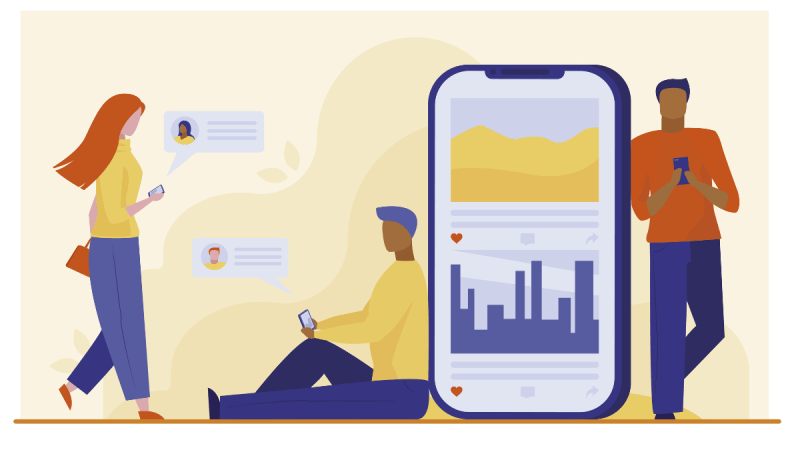The Role of Artificial Intelligence in Content Creation Today

The Role of Artificial Intelligence in Content Creation Today
Introduction:
Artificial Intelligence is everywhere, even in how we create blogs, articles, or social media posts. Tools such as ChatGPT and Jasper make it easier for anyone to churn out meaningful content quickly and efficiently, saving time and resources. People are celebrating the increase in productivity and all the content produced, but they did the same thing when websites popped up, and some are more cautious about the quality, creativity, and integrity of the process.
This post will show you how AI is changing the way content is produced. You will learn about the real benefits, the risks of the more familiar conversations, and what all of this means if you want to maintain the integrity of your content.
How AI Tools Work In Content Creation
AI can now fit into almost every part of the content production process. It’s more than writing an article and producing a short post. Whether it’s writing and editing, creating visual content, or handling the unnecessary busy work nobody wants to do, AI now plays a role in content production as your creative collaborator and production assistant. Here are a few ways these smart tools are making content development easier for anyone producing content today.
Text Generation And Editing With AI
AI-generated text-writing tools like ChatGPT and Jasper are not just simple generators of blocks of text. Consider them as very well-versed writing partners who can help you brainstorm, draft, and edit content in mere minutes. You can use these to write full blog articles, subject-area descriptions, social media post captions, or even destinations or municipal newsletters. These tools are designed to mimic the presentation of written sentences that sound both natural and coherent, often with nothing more than a prompt or idea.
AI clean writing quickly editing tools are much like spell-checkers (but smarter) and find issues related to grammar, spelling, and flow. They indicate poorly phrased sentences, suggest better words, and sometimes, can even rewrite portions of content to present as sharper. So, when you hit a wall or find yourself stalled, such tools will help you for sure, facilitating quality and output, without burnout.
Visual And Audio Content Creation
It’s not all about words. AI has even changed the way you deal with images, video, and sound. Tools like Midjourney and Canva’s text-to-image features will turn your idea into graphics, even if the most you can draw is a stick figure. Simply type what you want, like “a blue mountain sunrise for a blog graphic,” and get images to use.
On video, you can delegate the editing process to AI. You can find tools that will take raw clips and trim them, put in subtitles, or adjust the colors for you. Some apps will even take care of video montages with music and effects all put together in minutes. For audio, quick AI voiceover tools will produce spoken words directly from the text, including options for tonality and accentuation. This means you can add voice to videos without ever being in front of a mic.
AI allows you to:
- Create stunning visuals, regardless of design skill.
- Edit video content quickly, saving potentially hours of tedious work.
- Add quality voiceovers to videos/podcasts from simple scripts.
Automating Repetitive Content Tasks
Many creators will get hung up on tasks that are important but time-consuming. Handle your grunt work so you can do the work you want to do. Here is how:
- Transcription: AI transcribes audio and video files by listening to them and writing down each word, basically instantly. No more tedious hours rewinding recordings.
- Summarizing Meetings: After you finish a meeting or webinar, AI can summarize the important points and generate a summary. This keeps everyone informed without needing to replay a recording or sift through your notes.
- Reformatting Content: Do you need an image resized for an Instagram post? Or maybe you have a long article you want to rewrite as a Twitter thread? AI engines can resize or repurpose your existing content so it fits on several different digital channels.
These tools make it easy to overcome the pain of busy work while also making it easy for people to receive and consume updates, highlights, and any information you push out on any platform, with almost no physical effort on your part.
Benefits Of Using AI in Content Creation
If you are wondering why writers, marketers, and business owners are using AI tools, it isn’t just hype. AI is great when content creation gets tough or long. You get more work done, it costs you less, and your output is closer to what your audience is searching for. Here’s how AI helps you run faster, cheaper, and smarter.
Speed and Efficiency
AI takes research, drafts, and edits and gives it a turbo boost. No more spending hours trying to find sources to come up with ideas or trying to revise a poorly crafted sentence. With the right prompts, AI tools can surface facts, help you create an outline, or just put together a draft based on your main ideas in minutes. You’ll see this speed in every stage:
- Research: Input your topic into an AI tool and get instant suggestions, data, or keywords.
- Drafting: Put in a headline or sentence, and out pops the full article, blog, or social post in seconds.
- Editing: AI checks spelling, grammar, and flow while showing you what needs to be fixed. Instead of worrying about your first draft so much, you can move things along to the final product quickly and easily.
This means you’ll have more time to actively strategize or start up other projects instead of reacting to content demands.
Cost-Effectiveness
AI allows you to get more out of your content budget. You don’t have to rely upon a large team or expensive freelancers for every single post or update. AI can take care of the busy work, and you can stretch your resources.
Consider These Cost-Effective Changes:
Individual creators can produce more work of quality work without hiring new help.
Small teams can keep producing without using up their extra overtime or adding new employees.
Marketing budgets can stretch further, allowing less money to be spent on constant drafting and editing.
For businesses with limited budgets or individuals just starting to make content a priority, these savings allow for regular content updates to be maintained at a competitively low cost.
Personalization at Scale
AI enables you to easily personalize content for various readers, customers, or clients without having to create each piece fresh. Think of writing one article and then have AI rework that same content for a different audience, platform, or voice.
There are two ways AI utilizes personalization:
- Alter tone, style, or even reading level for groups/segments of readers.
- Alters language depending on the geographic location, interests, or demographics. Revises titles, sections, or calls to action to align with various sales funnels or various products.
Imagine reaching more of your audience with messages they relate to that feel like it was created for them while not spending more time customizing each deliverable. AI does the heavy lifting of personalization so you can engage each part of your audience.
AI’s Impact on Short-Form Video Platforms:
It’s a no-brainer that short-form video is king on social media, as it skyrockets in popularity, mostly thanks to Instagram Reels, TikTok, and Youtube Shorts. However, the challenge is still to cut through the noise of thousands of videos. This is the reason why AI creates new possibilities for creators of these platforms to innovate the way they create, optimize, and increase the visibility, engagement, and number of views to their Reels.
AI-Powered Editing And Effects
From AI editing tools like CapCut or Adobe Sensei and platform-built AI editing tools, creators can now use AI to automatically trim clips, apply trending effects, sync music, and even create subtitles within seconds, not only changing the pace, but visually engaging subscribers and/or followers, when trying to rack up TikTok likes, these views on Youtube, and most importantly increasing their views on Instagram reels.
Video Performance Optimization
AI editing tools do more than provide editing options; they provide performance guidance, too. AI shows creators analytical data based on information like watch time, drop-off times, and engagement rates on how to best curate video lengths, hooks, and formats to create a better chance for traction and an increase in overall Reel views.
Content Ideation And Trend Spotting
AI Platforms track trending content globally and identify breakthroughs of which audio, challenges, and content formats are going viral on trending Reels, TikToks, and Shorts. This means that content producers can stay one step ahead of the trend curve to create videos audiences are searching for on the internet, and the probability that it will go viral and see Reel’s views organically will be much higher.
Thumbnail And Caption Suggestions
Getting people to pause on your video is half the battle. For example, there are AI tools that are now creating custom thumbnails and recommending captions and hashtags based on what’s trending today. With more engaging visuals and optimized text, you will have a more clickable video, more reach, and, ultimately, Reels views!
Common Challenges And Concerns With AI Content
There are many positives when it comes to AI for content creators, as it makes the content creation process less work. However, the use of AI can also bring very real dilemmas and concerns. There are very large concerns about trust regarding facts, ownership, and the whole idea of “the future of real human style.” Some of these may be able to make you pause before handing the keyboard over. Understanding some of these challenges can help you see AI as a tool that may be good to use and not negatively impact your voice or brand.
Questions About Quality and Trust
Not all AIs are equal, so we probably have every reason to doubt getting it wrong, and it most probably could. Even the best AI tools may still very likely spit out a few errors or facts that seem to be true but are not in fact. You may discern that AI can miss the correct tone and may be boring, robotic, or exhibit awkward English!
About AI quality, concerns can be relatively categorized into three areas:
- Factual errors: AI can misunderstand dates, places, and names, or confuse/ displace important details if you are not careful.
- Tone and Voice issues: AI-generated writing may not have the warmth, humor, or bluntness that can be obvious even in human writing. It can occasionally not “get” maybe sarcasm, irony, or the way your audience speaks.
- Alignment issues: When you use multiple AI tools or prompts with variations, you can create confusion for your brand’s voice + style. This will leave your site (or social) feeling like a hodgepodge of content.
Trust is only built when you are posting content that is accurate and sounds like you. If you are using AI, you can expect to fact-check, edit tone, and make sure the content sounds like you and not a robot.
Originality and Copyright Issues
You don’t just want your content to be different, and you want to avoid court. With AI, you could end up with writing that is too similar to something already published. Furthermore, not all AI tools will ‘cite’ ideas, data, or quotes that they borrowed.
Here is where problems tend to pop up:
- Plagiarism issues: AI can borrow lines, phrases, and even data without saying where it came from, and there is no penalty. This could hurt your brand and maybe even your search ranking.
- Duplicate content: If you and one other person used the same tool, you may end up with nearly the same article (or social graphic), which starts nullifying the value of your site (or social).
- Unknown sources: The AI may borrow a quotation or fact from a blog, book, or website without us knowing, and that could lead to some pretty messy copyright situations.
- Solution: To cover yourself, run everything in AI through plagiarism checkers, attempt to inject your voice, and use prompts, but never have AI be the last piece. When in doubt, at the very least, attempt to find the source of an idea before you publish.
Over-Reliance on AI
There is a real danger that if you are relying on AI more and more, the less you will communicate your true style and ideas. Once the AI is doing the labor, and I mean the REAL labor, it can be easy to allow it to take over the creative side, but it will sap the approach/text/words of authenticity.
Risks of allowing a general AI to do what you want:
- Loss of voice: If everyone uses the same AI generically, everything sounds generic, and readers can identify when writing is flat, uninspired, or appears the same.
- Lost creative ideas: AI is great at remixing what exists online, but it cannot create something zany or new in the same way the human brain can.
- Too much volume – not enough soul: You can build outposts, one post after another, with AI, but the posts might stack to increase your traffic, still appear busy, but don’t reflect anything specific – nothing stands out.
You can get the best value from AI when you lean on it for support and not replacement. Let it grapple with your boring load or wrestle with the text or structure, then return to the first draft and inject whatever ideas, stories, or surprises you want. This is how your content remains alive and interesting to read.
Tips For Using AI Wisely In Your Content Creation
The combination of artificial intelligence with your spin can ease the content development process, particularly if you are deliberate in this space. Use AI to save time and to prompt an idea, but you will likely get your best results if you are attentive/aware of the process and own your voice. These practical suggestions will assist you in leveraging AI in an effective way while making sure your content is still factual and personal.
Keep Human Review in the Loop:
AI can provide you with a strong start. However, it does not think as you think. While AI’s writing may seem convincing, there are times when the facts slip. You must do your due diligence to check and double-check details to avoid giving out wrong information or coming off as careless to your audience. Here are some suggestions on how to keep your content accurate:
- Check facts: Look up statistics, quotes, or even definitions using reputable resources.
- Reading Out Loud: When you read content out loud, you pick up odd phrases, unnatural flow, or robotic language much more easily.
- Edit for clarity: Your first draft may be a gem, but don’t hesitate to redo parts that don’t sound like you.
- Scan tone: Make sure the tone aligns with your audience – serious, light-hearted, excited, or authoritative.
- Plagiarism checks: Use free or paid tools to spot lines with little or no original thought.
- Verify links and cited references: Make sure each suggestion or resource exists and is relevant.
You would not trust a stranger to complete your project without reviewing it. While AI is helpful, it still needs your eyes and judgment.
Mix AI With Your Ideas:
Your own stories and beliefs are the brushstrokes of color that fill out the canvas of your content. AI provides a blank canvas, but it will be your paintbrush that creates the picture for your audience to remember. Don’t settle for generic content—here’s how you can combine your ideas with an AI draft:
- Start with your outline: Think about your main ideas or stories before prompting the AI so the draft matches the way you are thinking about your piece.
- Rewrite the important sections: Include your own experiences, local facts, or real-world examples that the AI will never know.
- Tweak the intro and conclusion: Readers will remember the first and last lines, so make these sound like you, not a chatbot.
- Use “I” and “you”: This will keep your content direct, real, and relatable.
- Offer opinions: Don’t shy away from being in agreement or disagreement, and add your strong opinions that demonstrate your point of view.
- Include details the AI will skip: Slip in names of places, friends, or events you have details about.
By mixing the AI draft with your ideas and stories, you keep your content fresh and honest. Your readers want information, and they stick around for your unique opinions and take on things. Keep that balance, and you will never feel your words are bland or forgettable.
Conclusion
AI gives you a quicker way and new tools for creating content, but it should not replace your unique voice. Let the tools work for you in using your time efficiently and prompting ideas. But continue to inject your own stories and opinions into the mix. When you check the facts and put your unique style on top, you build trust and make your writing tangible.
If you haven’t tried the newest AI tools out there, give them a go and see if they can assist in your workflow, but don’t ever let them speak for you! Your value is in what you can uniquely share. If this post made you think or learn something new, feel free to share your thoughts or tell others about what is working for you. Thank you for spending your time here.
Author bio
Megan Allen is a Social media Content writer and well experienced content writer at Boostiglikes.com. She writes all things related to business, marketing, and entrepreneurship on several websites. Her passion includes travelling to all places around the world.





